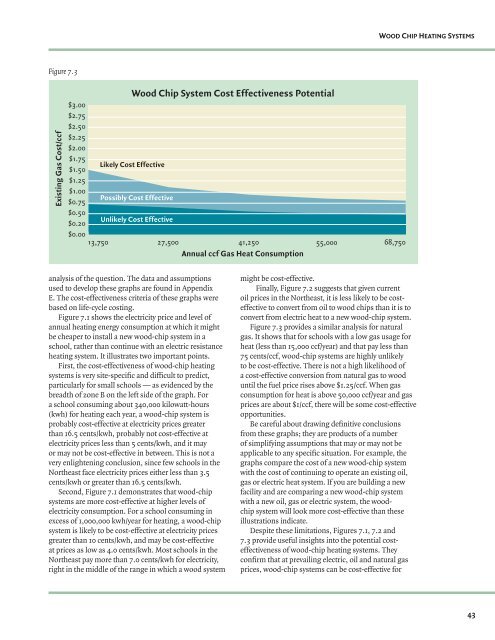Wood-Chip Heating Systems - Biomass Energy Resource Center
Wood-Chip Heating Systems - Biomass Energy Resource Center
Wood-Chip Heating Systems - Biomass Energy Resource Center
Create successful ePaper yourself
Turn your PDF publications into a flip-book with our unique Google optimized e-Paper software.
Figure 7.3<br />
Existing Gas Cost/ccf<br />
$3.00<br />
$2.75<br />
$2.50<br />
$2.25<br />
$2.00<br />
$1.75<br />
$1.50<br />
$1.25<br />
$1.00<br />
$0.75<br />
$0.50<br />
$0.20<br />
$0.00<br />
<strong>Wood</strong> <strong>Chip</strong> System Cost Effectiveness Potential<br />
Likely Cost Effective<br />
Possibly Cost Effective<br />
Unlikely Cost Effective<br />
13,750 27,500 41,250 55,000<br />
Annual ccf Gas Heat Consumption<br />
analysis of the question. The data and assumptions<br />
used to develop these graphs are found in Appendix<br />
E. The cost-effectiveness criteria of these graphs were<br />
based on life-cycle costing.<br />
Figure 7.1 shows the electricity price and level of<br />
annual heating energy consumption at which it might<br />
be cheaper to install a new wood-chip system in a<br />
school, rather than continue with an electric resistance<br />
heating system. It illustrates two important points.<br />
First, the cost-effectiveness of wood-chip heating<br />
systems is very site-specifi c and diffi cult to predict,<br />
particularly for small schools — as evidenced by the<br />
breadth of zone B on the left side of the graph. For<br />
a school consuming about 340,000 kilowatt-hours<br />
(kwh) for heating each year, a wood-chip system is<br />
probably cost-effective at electricity prices greater<br />
than 16.5 cents/kwh, probably not cost-effective at<br />
electricity prices less than 5 cents/kwh, and it may<br />
or may not be cost-effective in between. This is not a<br />
very enlightening conclusion, since few schools in the<br />
Northeast face electricity prices either less than 3.5<br />
cents/kwh or greater than 16.5 cents/kwh.<br />
Second, Figure 7.1 demonstrates that wood-chip<br />
systems are more cost-effective at higher levels of<br />
electricity consumption. For a school consuming in<br />
excess of 1,000,000 kwh/year for heating, a wood-chip<br />
system is likely to be cost-effective at electricity prices<br />
greater than 10 cents/kwh, and may be cost-effective<br />
at prices as low as 4.0 cents/kwh. Most schools in the<br />
Northeast pay more than 7.0 cents/kwh for electricity,<br />
right in the middle of the range in which a wood system<br />
might be cost-effective.<br />
Finally, Figure 7.2 suggests that given current<br />
oil prices in the Northeast, it is less likely to be costeffective<br />
to convert from oil to wood chips than it is to<br />
convert from electric heat to a new wood-chip system.<br />
Figure 7.3 provides a similar analysis for natural<br />
gas. It shows that for schools with a low gas usage for<br />
heat (less than 15,000 ccf/year) and that pay less than<br />
75 cents/ccf, wood-chip systems are highly unlikely<br />
to be cost-effective. There is not a high likelihood of<br />
a cost-effective conversion from natural gas to wood<br />
until the fuel price rises above $1.25/ccf. When gas<br />
consumption for heat is above 50,000 ccf/year and gas<br />
prices are about $1/ccf, there will be some cost-effective<br />
opportunities.<br />
Be careful about drawing defi nitive conclusions<br />
from these graphs; they are products of a number<br />
of simplifying assumptions that may or may not be<br />
applicable to any specifi c situation. For example, the<br />
graphs compare the cost of a new wood-chip system<br />
with the cost of continuing to operate an existing oil,<br />
gas or electric heat system. If you are building a new<br />
facility and are comparing a new wood-chip system<br />
with a new oil, gas or electric system, the woodchip<br />
system will look more cost-effective than these<br />
illustrations indicate.<br />
Despite these limitations, Figures 7.1, 7.2 and<br />
7.3 provide useful insights into the potential costeffectiveness<br />
of wood-chip heating systems. They<br />
confi rm that at prevailing electric, oil and natural gas<br />
prices, wood-chip systems can be cost-effective for<br />
WOOD CHIP HEATING SYSTEMS<br />
68,750<br />
43





